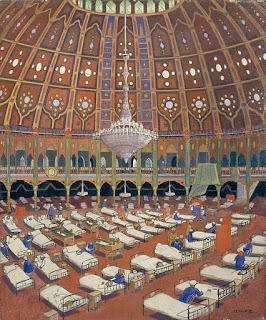Mapping untold stories of World War 1
 |
|
Indian Army wounded dressed in
‘Convalescent Blue’
outfit in the Dome, Brighton
|
When what you’re looking at is too huge to understand, you reach for a map. Body density maps of World War One is one way to attempt to ‘picture’ where death happened (see over the top). You might begin to visualise impact of those deaths by mapping the streets they left behind. But what about the casualties from physical wounds, illness, and emotional trauma?
We know there were many more than those who died, but have no fixed number. Their injuries and return from fighting is well documented, but how can we even begin to understand the immensity of change in the lives of people living in, or patients staying in Birmingham?
A first glance at resources already available at the Library of Birmingham gives some idea of the depth and quality of information available on World War One generally, and also the absence of the wounded in more ‘mainstream’ histories – very much the purpose of our untold stories project.
 |
| The Great Hall University of Birmingham in 1916 http://www.voicesofwarandpeace.org/ |
By Spring 1919, some 130,000 military casualties had been treated in the Birmingham hospitals. The majority had suffered wounds or sickness on the Western Front, but this total included men coming from all of the theatres of war, plus Belgian and Serbian troops, men from the navy, and prisoners of war.
Birmingham had a population of half a million – the arrival of so many wounded soldiers changed the city. It is no coincidence Birmingham still has a major military presence at QE hospital, and specialises in surgery & critical care.
We wanted to find out:
- Where were the hospitals and convalescent homes?
- What information is there about the patients and staff?
- What happened to the men after they were discharged?
- How did the city look after them?
- How did local residents react to injured soldiers?
- How did attitudes towards serious physical and mental injury change as a result of the Great War?
Untold stories brought together pieces of our existing knowledge with new research, to tell a more comprehensive story of what happened to returning soldiers with injuries; both physical and mental. We explored the people who were directly involved and the impact on the city as a whole during the immediate war period and in the subsequent decades. Reflected across all our archives there is a lack of representation of people with disabilities and yet, especially in a city like Birmingham, their absence prevents understanding our history as a whole.
Our first step was to find the hospitals and convalescent homes of Birmingham in World War One (see map below).
Untold stories learning resources will be publicly launched 13th September 2016 6:30 to 8pm at Highbury Hall – join us to find out more.
Following official launch resources will also be available via this website.


A critic is someone who never actually goes to the battle, yet who afterwards comes out shooting the wounded. See the link below for more info.
#wounded
http://www.ufgop.org